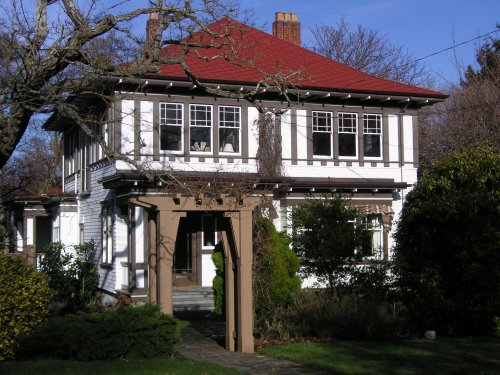2012/2014 Runnymede Avenue


The Mrs. Mary Piggott House is a handsome foursquare, two-storey Edwardian Vernacular house with Tudor-Revival details; it terminates the vista from Mountjoy Avenue and sits in a mature, manicured garden that includes an arbour over the front walk. It is identifiable for its pyramidal roof, half-timbered cladding and characteristic offset entrance.
The Mrs. Mary Piggott House is an important component of the Runnymede cluster of contemporaneous heritage homes, and it provides a significant demonstration of the social, cultural, and economic history of the area. The houses in this cluster are on land formerly owned by the Pemberton family, descendants of Joseph Despard Pemberton, first Surveyor General of the colony of Vancouver Island, and adjacent to Frederic Pemberton family home, 'Mountjoy'. They were all designed by prominent architects, many having a similar architectural vocabulary – British Arts and Crafts; and were commissioned by affluent professional clients. Built in 1911, was one of the 1,500 houses built in Oak Bay between 1910 and 1913 at a time when Oak Bay was undergoing a period of rapid development. Unlike many of the large houses in the area which have been converted to suites as a result of the changing needs of families, and the rising price of real estate in the area, this has remained a single family dwelling.
This Foursquare residence is embellished with Tudor Revival details, and is a rare example of this architectural style, in Oak Bay; British Arts and Crafts being the favoured architectural idiom. But here the popular simple Edwardian box has been ornamented in Oak Bay style with Tudor Revival details such as half-timbering, and deep eaves; as well there are Queen Anne Revival details such as the glazing-bar pattern in the upper sashes, all resulting in a rare essay in eclectic architecture.
The heritage value of the Mary Piggott House is its association with William D’Oyley Hamilton Rochfort (1884–1943), who arrived in Victoria from England via San Francisco in 1903 and was Mary Piggott’s son’s brother-in-law. With no formal architectural training, Rochfort was hired by Samuel Maclure for his natural artistic ability, and his style was heavily influenced by Maclure. He designed a number of residences in the Tudor Revival style based on a Foursquare plan, with cladding and window details similar to those found on the Mrs. Mary Piggott House. This house was built the same year as her son’s house, formerly next door at 2028 Runnymede, which was designed by Rochfort; and he is considered to be the architect of this site.
- location, visual termination north of Mountjoy Avenue
- residential setback, set in heritage cluster of architect-designed single family dwellings
- form, scale and massing
- shingled pyramidal hipped roof with bell-cast
- wood frame construction with concrete and random rubble-stone foundations
- style details such as: shingles on first storey, stucco and half-timbering on the second; offset entrance, porch with balustrade and posts; deep eaves with exposed joist ends; multi-paned wooden front door with original hardware and sidelights; Queen Anne Revival glazing-bar pattern in upper sashes
- exterior architectural details such as: two internal chimneys with decorative brick chimney-stacks; string courses
- fenestration, and window types such as: double-hung sashes, multi-pane over single pane, in single- and multiple-assembly; margin lights; stained-glass stair window
- original interior elements such as: woodwork, doors, door hardware, fireplaces, light fixtures
- landscape features: sympathetic arbour at entrance path, mature coniferous and deciduous trees and shrubs
 Instagram
Instagram
 Facebook
Facebook
 Twitter
Follow @DistrictOakBay
Twitter
Follow @DistrictOakBay